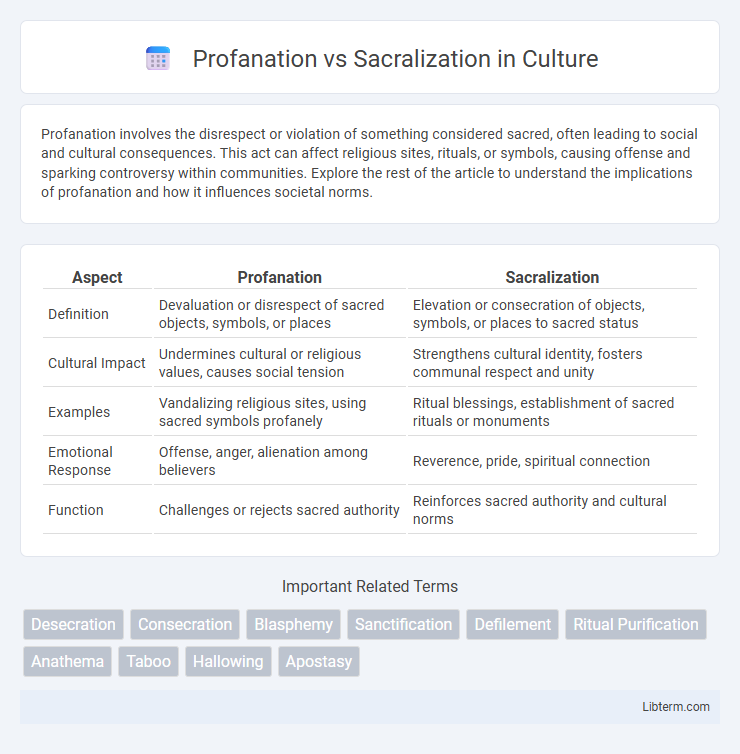Profanation involves the disrespect or violation of something considered sacred, often leading to social and cultural consequences. This act can affect religious sites, rituals, or symbols, causing offense and sparking controversy within communities. Explore the rest of the article to understand the implications of profanation and how it influences societal norms.
Table of Comparison
| Aspect | Profanation | Sacralization |
|---|---|---|
| Definition | Devaluation or disrespect of sacred objects, symbols, or places | Elevation or consecration of objects, symbols, or places to sacred status |
| Cultural Impact | Undermines cultural or religious values, causes social tension | Strengthens cultural identity, fosters communal respect and unity |
| Examples | Vandalizing religious sites, using sacred symbols profanely | Ritual blessings, establishment of sacred rituals or monuments |
| Emotional Response | Offense, anger, alienation among believers | Reverence, pride, spiritual connection |
| Function | Challenges or rejects sacred authority | Reinforces sacred authority and cultural norms |
Understanding Profanation: Definition and Origins
Profanation refers to the act of treating something sacred with irreverence or disrespect, often stripping it of its spiritual significance. Originating from the Latin term *profanare*, meaning "to defile" or "to desecrate," profanation historically contrasts with sacralization, the process of making something sacred or holy. Understanding profanation involves recognizing its role in social and religious contexts where sacred symbols, rituals, or spaces are secularized or desacralized.
What is Sacralization? Meaning and History
Sacralization refers to the process by which objects, places, or concepts acquire sacred or spiritual significance within a culture or religion. Historically, sacralization has been integral to human societies, transforming everyday elements into symbols of divine or moral importance, often through rituals, myths, or religious practices. This process contrasts with profanation, which involves the loss or violation of sacred status, highlighting the dynamic nature of sacred meaning in cultural contexts.
Key Differences Between Profanation and Sacralization
Profanation involves the desecration or disrespect of something considered sacred, often leading to its devaluation or loss of spiritual significance. Sacralization, by contrast, is the process of attributing sacredness or sanctity to objects, places, or rituals, thereby imbuing them with religious or cultural importance. The key difference lies in profanation's role in diminishing sanctity, while sacralization enhances or creates sacred meaning.
The Role of Religion in Profanation and Sacralization
Religion plays a pivotal role in both profanation and sacralization by defining what is considered sacred and what is deemed profane within a society. Sacred objects, spaces, and rituals are sanctified through religious beliefs and practices, establishing boundaries that protect and honor the sacred, while acts of profanation challenge or violate these boundaries, often provoking religious or social responses. The dynamic interplay between profanation and sacralization reflects how religions maintain cultural cohesion and negotiate the meaning of the sacred in everyday life.
Cultural Contexts: How Societies Profane and Sacralize
Societies profane and sacralize objects, spaces, and rituals based on collective beliefs, historical narratives, and cultural values that define sacredness within a given context. Cultural practices such as religious ceremonies, festivals, and taboos delineate what is revered versus what is defiled or ordinary, reflecting the community's social order and identity. The process of sacralization elevates elements to a revered status through ritualistic recognition, while profanation often challenges or diminishes that sacred status by exposing the element to mundane or disrespectful treatment.
Profanation in Art, Literature, and Media
Profanation in art, literature, and media involves the deliberate subversion or desecration of sacred symbols and themes to challenge societal norms, provoke thought, or critique religious institutions. This practice often recontextualizes religious icons or narratives, transforming them into tools for social commentary or political dissent, as seen in works by artists like Andres Serrano or authors like Salman Rushdie. The strategic use of profanation fosters dialogue about the boundaries between sacred and secular, highlighting tensions within cultural and ideological frameworks.
Sacralization in Modern Rituals and Traditions
Sacralization in modern rituals and traditions involves the process of attributing sacred significance to objects, places, or practices that were previously secular or neutral, thereby transforming their cultural and emotional value. This phenomenon is evident in contemporary ceremonies such as national commemorations, sports events, and digital memorials where symbols and narratives are elevated to evoke collective identity and spiritual connection. The dynamic interplay between sacralization and profanation shapes how societies redefine sacredness, maintaining cultural cohesion while adapting to evolving social contexts.
Case Studies: Famous Acts of Profanation
Profanation involves the desecration or disrespectful treatment of sacred objects, spaces, or symbols, as seen in the 1989 vandalism of the Berlin Wall's religious murals, which challenged the sanctity attributed to the historical site. Another notable case is the 2012 burning of a Quran in Florida, igniting global outrage and highlighting the tension between freedom of expression and sacred respect. These acts underscore societal conflicts surrounding sacred values, often sparking debates on cultural sensitivity and legal boundaries related to sacralization.
The Impact of Sacralization on Social Norms
Sacralization transforms social norms by infusing them with religious or spiritual significance, reinforcing collective identity and moral behavior. This process elevates everyday practices to sacred rituals, thereby strengthening social cohesion and legitimizing authority structures. By sacralizing certain values or symbols, societies create powerful normative frameworks that guide individual actions and maintain order.
Profanation vs Sacralization: Contemporary Debates and Perspectives
Profanation and sacralization represent opposing processes where profanation involves the desacralization or secularization of sacred objects, spaces, or rituals, while sacralization entails the imbuing of ordinary elements with sacred meaning. Contemporary debates focus on how globalization, cultural shifts, and technological advancements influence these processes, often highlighting tensions between modern secular values and traditional religious practices. Scholars analyze case studies ranging from urban space transformations to digital religion, revealing complex dynamics where sacralization and profanation coexist, challenge, or reinforce each other in evolving social contexts.
Profanation Infographic

 libterm.com
libterm.com